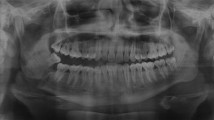Abstract
Introduction
This study was performed to evaluate the efficacy and post-operative complication of 3-dimensional (3D) titanium miniplate and locking plate in mandibular fractures (parasymphysis, symphysis, body, and angle).
Materials and methods
Forty patients, with non-comminuted mandibular fractures treated with open reduction and internal fixation using 3D titanium miniplate system or locking plate system through an intra-oral approach, were included in this study. All patients were systematically monitored up to 2 months post-operatively. Parameters recorded were infection, occlusal discrepancies, hardware failure, wound dehiscence, sensory disturbance of the inferior alveolar nerve, and stability of fractured segments.
Results
Forty patients with mandibular fracture were divided into two groups randomly without any bias. The fractures of all 40 patients were found to be adequately fixed when checked intra-operatively after fixation. One patient (2.5%) of the 3D plate group developed an infection on the first and second post-operative visit and was treated by antibiotic coverage. One patient in the locking plate group (2.5%) reported wound dehiscence after the first week follow-up.
Conclusion
Both 3D titanium miniplates and locking plate are effective in the treatment of mandibular fractures, and overall complication rates are lesser. However, the 3D plating system uses less hardware in cases of parasymphysis and symphysis fractures and more hardware in cases of body and angle fractures.






Similar content being viewed by others
References
Collins CP, Galia PL, Andrew T, Rafael A (2004) A prospective randomized clinical trial comparing 2.0-mm locking plates to 2.0-mm standard plates in treatment of mandible fractures. J Oral Maxillofac Surg 62:1392–1395
Champy M, Lodde JP, Schmidt R, Jaeger JH, Muster D (1978) Mandibular osteosynthesis by miniature screwed plates via a buccal approach. J Maxillofac Surg 6:14–21
Renton TF, Wiesenfeld D (1996) Mandibular fracture osteosynthesis: a comparison of three techniques. Br J Oral Maxillofac Surg 34:166–113
Ellis III, Graham J (2002) Use of a 2.0-mm locking plate/screw system for mandibular fracture surgery. J Oral Maxillofac Surg 60:642–645
Mustafa F (1995) Three dimensional plate fixation of fractures and osteotomies. Facial Plast Surg Clin North Am 3:39–56
Brian A, Rolf G, Schmelzeisen R (2003) New innovations in craniomaxillofacial fixation: the 2.0 lock system. Keio J Med 52(2):120–127
Parmar BS, Shailesh M, Raghani M, Toral K (2007) Three dimensional miniplate rigid fixation in fracture mandible. J Maxillofac Oral Surg 6:14–16
Anand SS, Thangavelu A (2004) Role of indigenous 3-D plating system in oral and maxillo facial surgery. J Maxillofac Oral Surg 3(1):24–27
Juergen Z, Olivier L, Tateyuki L (2007) Use of straight and curved 3-dimensional titanium miniplates for fracture fixation at the mandibular angle. J Oral Maxillofac Surg 65:1758–1763
Guimond C, Johnson JV, Marchena JM (2005) Fixation of mandibular angle fractures with a 2.0 mm 3-dimensional curved angle strut plate. J Oral Maxillofac Surg 63:209–214
Singh V, Kumar I, Bhagol A (2011) Comparative evaluation of 2.0-mm locking plate system vs 2.0-mm nonlocking plate system for mandibular fracture: a prospective randomized study. Int J Oral Maxillofac Surg 40(4):372–377
Kumar JM, Manjunath KS, Bhagwan BK, Shah DK (2010) Comparison of 3-dimensional and standard miniplate fixation in the management of mandibular fractures. J Oral Maxillofac Surg 68:1568–1572
Bui P, Demian N, Beetar P (2009) Infection rate in mandibular angle fracture treated with a 2.0mm 8-hole curved strut plate. J Oral Maxillofac Surg 67:804–808
Sauerbier S, Kuenz J, Hauptmann S, Frederikoogendijk C, Liebehenschel N, Schön R, Schmelzeisen R, Gutwald R (2010) Clinical aspects of a 2.0-mm locking plate system for mandibular fracture surgery. J Craniomaxillofac Surg 38:501–504
Moreno JC, Fernandez A, Ortiz Jose A, Montalvo JJ (2000) Complication rates associated with different treatments for mandibular fractures. J Oral Maxillofac Surg 58:273–280
Cawood JI (1985) Small plate osteosynthesis of mandibular fractures. British Journal of Oral & Maxillofacial Surgery 23:77–91
Acknowledgements
We would like to acknowledge Dr. Sulbh Aggarwal on her valuable help in fabrication of the manuscript.
Author information
Authors and Affiliations
Corresponding author
Ethics declarations
Conflict of interest
The authors declare that they have no conflict of interest regarding this article.
Role of funding source
The materials used in the study were self-funded by the corresponding author.
Ethical approval and informed consent
The study was approved by the Ethical Committee on Human/Animal Subjects Research at the Kothiwal Dental College and Research Centre under the reference number KDR/ETH/OMFS/2011/03 and was conducted in full accordance with the World Medical Association’s Declaration of Helsinki. Informed consent was taken in addition to surgical consent from all the participants involved in the study, and the procedure was approved by the ethics committee.
Rights and permissions
About this article
Cite this article
Aggarwal, S., Singh, M., Modi, P. et al. Comparison of 3D plate and locking plate in treatment of mandibular fracture—a clinical study. Oral Maxillofac Surg 21, 383–390 (2017). https://doi.org/10.1007/s10006-017-0642-1
Received:
Accepted:
Published:
Issue Date:
DOI: https://doi.org/10.1007/s10006-017-0642-1




